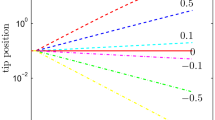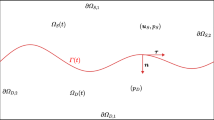Abstract
A mathematical model of angiogenic tumor growth in tissue with account of bevacizumab therapy was developed. The model accounts for convective flows that occur in dense tissue under active division of tumor cells, as well as the migration and proliferation dichotomy of malignant cells, which depends on the concentrations of major metabolites, such as oxygen and glucose. Tumor cells wich are in a state of metabolic stress produce vascular endothelial growth factor, which stimulates angiogenesis. To establish the relationship between the capillary network density and oxygen supply, a separate model of stationary blood flow in the capillary network was developed and investigated. A numerical study of the tumor-growth model showed that antiangiogenic bevacizumab treatment of tumors of the diffuse type reduces the total number of their cells, but practically does not affect the rate of their invasion into normal tissues. At the same time, it was found that the growth of dense tumors may be non-monotonic in a rather wide range of parameters. It was shown that in this case bevacizumab therapy stabilizes and significantly inhibits tumor growth, while its local-in-time efficiency is sensitive to the time that it begins.
Similar content being viewed by others
Abbreviations
- VEGF:
-
vascular endothelial growth factor
References
J. Folkman, P. Cole, and S. Zimmerman, Ann. Surg. 164 (3), 491 (1966).
M. Welter, K. Bartha and H. Rieger, J. Theor. Biol. 259 (3), 405 (2009).
J. Folkman, New Engl. J. Med. 285 (21), 1182 (1971).
T. H. Adair and J.-P. Montani, Angiogenesis (Morgan & Claypool Life Sciences, San Rafael, CA, 2010).
P. Carmeliet and R. K. Jain, Nature 407 (6801), 249 (2000).
B. Drogat, P. Auguste, et al., Cancer Res. 67 (14), 6700 (2007).
M. A. Konerding, C. van Ackern, and E. Fait, in Blood Perfusion and Microenvironment of Human Tumors: Implications for Clinical Radiooncology, Ed. by M. Molls and P. Vaupel (Springer, Berlin, 2002), pp. 5–17.
S. K. Stamatelos, E. Kim, A. P. Pathak, and A. S. Popel, Microvasc. Res. 91, 8 (2014).
J. E. Fletcher, Math. Biosci. 38 (3–4), 159 (1978).
J. B. Geddes, R. T. Carr, F. Wu, et al., Chaos 20 (4), 045123 (2010).
A. S. Kholodov, A. V. Evdokimov, and S. S. Simakov, in Mathematical Biology: Recent Trends (Anamaya Publishers, New Delhi, 2006), pp. 22–29.
A. Eberhard, S. Kahlert, V. Goede, et al., Cancer Res. 60 (5) 1388 (2000).
K. R. Swanson, R. C. Rockne, J. Claridge, et al., Cancer Res. 71 (24), 7366 (2011).
A. V. Kolobov and M. B. Kuznetsov, Russ. J. Numeric. Anal. Math. Model. 28 (5), 471 (2013).
N. V. Mantzaris, S. Webb, and H. G. Othmer, J. Math. Biol. 49 (2), 111 (2004).
F. Milde, M. Bergdorf, and P. Koumoutsakos, Biophys. J. 95 (7), 3146 (2008).
Y. Cai, J. Wu, Z. Li, and Q. Long, PLOS ONE 11 (3), e0150296 (2016).
B. Szomolay, T. D. Eubank, R. D. Roberts, et al., J. Theor. Biol. 303, 141 (2012).
S. D. Finley and A. S. Popel, J. Natl. Cancer Inst., djt093 (2013).
L. Soto-Ortiz, J. Theor. Biol. 394, 197 (2016).
A. V. Kolobov and M. B. Kuznetsov, Biophysics (Moscow) 60 (3), 449 (2015).
A. V. Kolobov, V. V. Gubernov, and M. B. Kuznetsov, Russ. J. Numeric. Anal. Math. Model. 30 (5), 289 (2015).
A. Giese, R. Bjerkvig, M. E. Berens, and M. Westphal, J. Clin. Oncol. 21, 1624 (2003).
A. V. Gusev and A. A. Polezhaev, Kratk. Soobshch. Fiz. FIAN Nos. 11–12, 85 (1997).
M. A. Konerding, C. van Ackern, and E. Fait, in Blood Perfusion and M icroenvironment of Human Tumors: Implications for Clinical Radiooncology, Ed. by M. Molls and P. Vaupel (Springer, Berlin, 2002), pp. 5–17.
A. G. Kamkin and A. A. Kamensky, Fundamental and Clinical Physiology (Akademiya, Moscow, 2004) [in Russian].
R. N. Pittman, in Colloquium Series on Integrated Systems Physiology: From Molecule to Function (Morgan & Claypool Life Sciences, 2011), Vol. 3 (3), pp. 1–100.
L. Garby and J. Meldon, in The Respiratory Functions of Blood (Springer New York, 1977), pp. 35–110.
J. R. Levick, An Introduction to Cardiovascular Physiology (Butterworth-Heinemann, Oxford, 2013).
S. Simakov, I. Ispolatov, S. Maslov, and A. Nikitin, in Pathway Analysis for Drug Discovery, Ed. by A. Yuryev (Wiley, 2008), Chap. 4, pp. 67–102.
A. T. Falk, J. Barriere, E. Francois, and P. Follana, Critical Rev. Oncol. Hematol. 94 (3), 311 (2015).
O. N. Pyaskovskaya, D. L. Kolesnik, A. V. Kolobov, et al., Exp. Oncol. 30, 269 (2008).
K. Groebe, S. Erz, and W. Mueller-Klieser, Adv. Experim. Med. Biol. 361, 619 (1994).
J. J. Casciari, S. V. Sotirchos, and R. M. Sutherland, Cell Prolif. 25 (1), 1 (1992).
C. Androjna, J. E. Gatica, J. M. Belovich, and K. A. Derwin, Tissue Eng. A 14 (4), 559 (2008).
A. Carreau, B. E. Hafny-Rahbi, A. Matejuket, et al., J. Cell. Mol. Med. 15 (6), 1239 (2011).
J. M. Kelm, C. D. Sanchez-Bustamante, E. Ehler, et al., J. Biotechnol. 118 (2), 213 (2005).
K. J. Kim, B. Li, J. Winer, et al., Nature 362, 841 (1993).
J. Kleinheinz, S. Jung, K. Wermker, et al., Head Face Med. 6 (1), 17 (2010).
N. Papadopoulos, J. Martin, Q. Ruan, et al., Angiogenesis 15, 171 (2012).
Genentech Inc., Avastin Full Prescribing Information. http://www.gene.com/download/pdf/avastinprescribing.pdf (2015).
I. B. Petrov and A. I. Lobanov, Lectures in Computational Mathematics (Internet Univ. Inform Techol., Moscow, 2006) [in Russian].
J. P. Boris and D. L. Book, J. Comput. Phys. 11 (1), 38 (1973).
Author information
Authors and Affiliations
Corresponding author
Additional information
Original Russian Text © M.B. Kuznetsov, N.O. Gorodnova, S.S. Simakov, A.V. Kolobov, 2016, published in Biofizika, 2016, Vol. 61, No. 5, pp. 1029–1039.
Rights and permissions
About this article
Cite this article
Kuznetsov, M.B., Gorodnova, N.O., Simakov, S.S. et al. Multiscale modeling of angiogenic tumor growth, progression, and therapy. BIOPHYSICS 61, 1042–1051 (2016). https://doi.org/10.1134/S0006350916050183
Received:
Published:
Issue Date:
DOI: https://doi.org/10.1134/S0006350916050183




